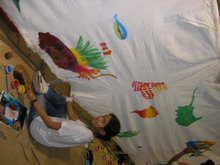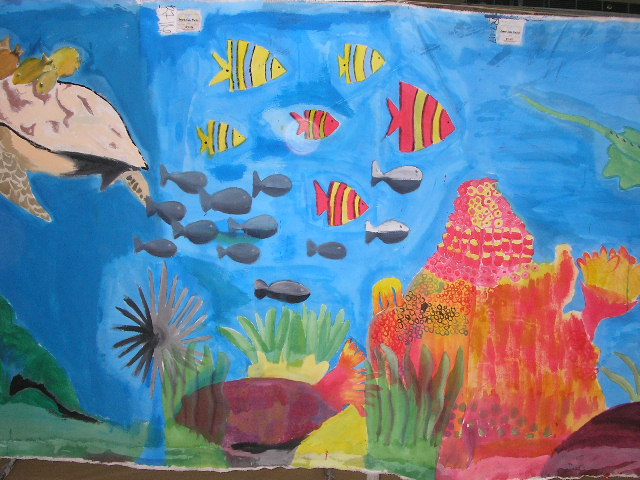I want to share with you guys some facts that may open our eyes a bit on what is happening to our environment. Do you know that the Philippines is home to a wide array of plant and animal species? According to Dr. Lawrence Heaney of the University of Chicago who has conducted field researches and training programs in the Philippines, the Philippines is like the Galapagos Islands multiplied tenfold. More than 510 species of land mammals, birds, reptiles and amphibians exist only in the Philippines.
Here’s more. Are you a fan of the noontime game show Game Ka Na Ba? If yes, maybe you had seen one episode of the original GKNB where the million-peso question was (translated in English): “Where in the Philippines would you find the most endangered bird in the world, Dicaeum quadricolor?” I remembered hearing my mother, who was also watching the show, answering “Cebu”. Unfortunately, the male contestant did not hear my mother’s answer, otherwise, he could have won one million pesos. Instead he answered “Palawan”. Of course he was wrong and my mother was right!
 The Cebu flowerpecker, Dicaeum quadricolor, is considered critically endangered. The 10-centimeter-long bird has been presumed extinct since 1905. Historical records show that specimens were collected from Toledo and Cebu City in periods earlier than 1950. It was reported as rediscovered on February 1982 in Tabunan, a remnant patch of forest at Central Cebu National Park. This led to a wave of conservation interests in the site. The Tabunan forest is also home to the largest known stand of Cebu Black Shama bird or “siloy” and Cebu Cinnamon Tree.
The Cebu flowerpecker, Dicaeum quadricolor, is considered critically endangered. The 10-centimeter-long bird has been presumed extinct since 1905. Historical records show that specimens were collected from Toledo and Cebu City in periods earlier than 1950. It was reported as rediscovered on February 1982 in Tabunan, a remnant patch of forest at Central Cebu National Park. This led to a wave of conservation interests in the site. The Tabunan forest is also home to the largest known stand of Cebu Black Shama bird or “siloy” and Cebu Cinnamon Tree. The Tabunan forest is the only home of the Cebu flowerpecker and its area has shrunk to a mere 185 hectares of forested land. Tabunan is one of the largest remaining fragments of original forest left on Cebu. It is probably the last hope for some of Cebu’s few remaining unique wildlife treasures.
The Tabunan forest is the only home of the Cebu flowerpecker and its area has shrunk to a mere 185 hectares of forested land. Tabunan is one of the largest remaining fragments of original forest left on Cebu. It is probably the last hope for some of Cebu’s few remaining unique wildlife treasures.The Cebu flowerpecker is much similar to the other Philippine flowerpeckers if not for its four colors (hence the name quadricolor). The bird has a grayish-white underbelly, black back with a bright red, triangular patch and a green rump. It is also distinguishable from the other flowerpeckers through its chirping.
Intensive fieldwork since then has confirmed only four birds in existence – two adult males, an adult female and an unidentified juvenile. The Cebu flowerpecker has virtually never been studied because it is so rare, but it appears to be breeding in Cebu, particularly, the Tabunan forest. This species of bird is considered to be ‘strictly confined to forest’. Recent observations indicate that it is associated only with tall, closed–canopy conditions. The forest at Tabunan, which lies in a thin-segmented strip on a steep and very uneven, west-facing limestone hillside, barely possesses any closed-canopy areas. This is because much of it has been selectively (but heavily) logged, affected by landslides, and because of the angle of the slope on which it stands.
Cebu flowerpecker feeds on small fruits (berries) in the canopy of a forest tree. This is first observed in December 1992 as a male species was noted feeding on a fruit in the canopy of a tree, confirming the assertion that its food is fruit and suggesting, along with the stoutness of the bill the species is a canopy frugivore (fruit eater).
Not much has been studied on the reproductive and breeding behavior of this avian species. Most, if not all, of the characteristics being described are observed not in captivity but in the natural habitat of the Cebu flowerpecker. A study in captivity of this bird has some constraints basically because they only number a few and they may not survive out from their natural place. Breeding was reported in the month of June by F.S Bourns and D.C Worcester, possibly on the basis of four young birds (three males, one female) they collected in June and July 1992 and described in their notes. Observations of four birds apparently with bright pink legs (possibly a seasonal character), chasing each other very actively, and at least one of them, a singing male, in March 1993, suggest breeding-season ebullience. Due to the bird’s rarity, no substantial study has been made in the reproductive cycle of such species.





















No comments:
Post a Comment